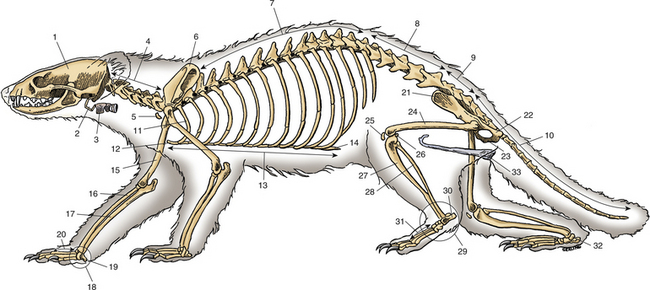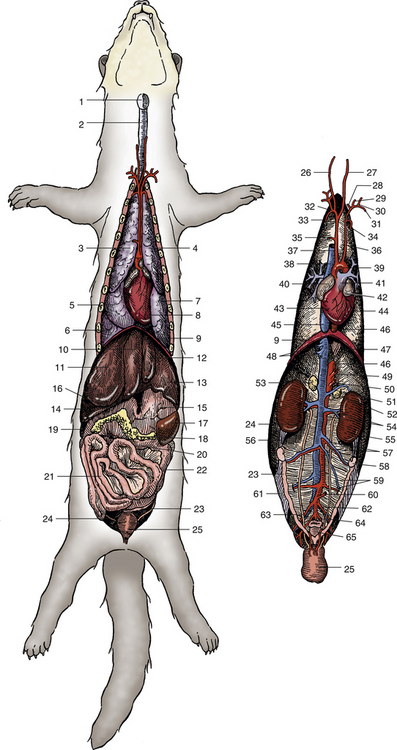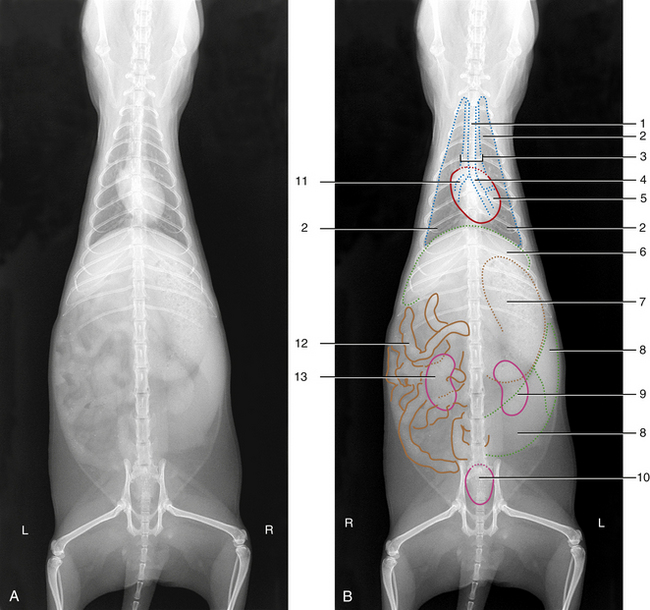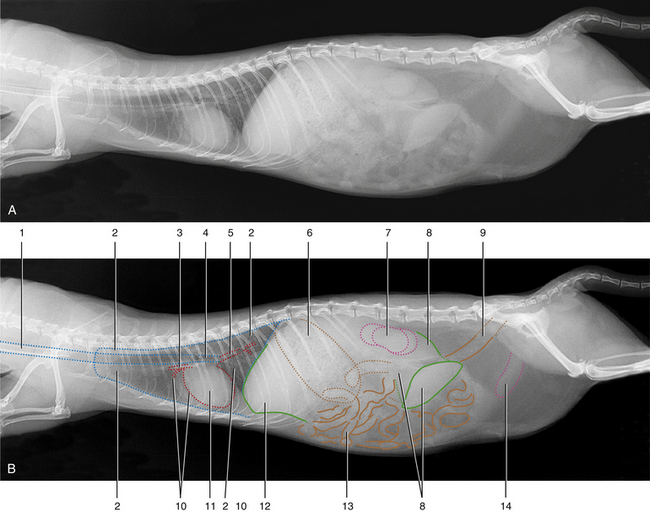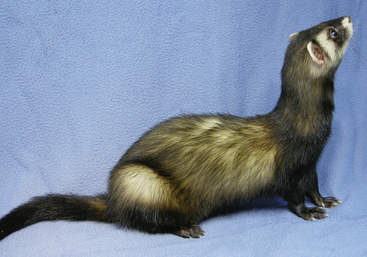Chapter 1 Basic Anatomy, Physiology, and Husbandry
Domestication History
Ferrets belong to the family Mustelidae and are related to weasels, mink, otters, badgers, stoats, and martens. There are currently three living species of ferrets (also known as polecats in Europe and Asia): the European polecat (Mustela putorius), the Steppe or Siberian polecat (Mustela eversmanni), and the black-footed ferret (Mustela nigripes). All three species live primarily solitary social lives and are very efficient hunters supporting their obligate carnivore lifestyle. The European polecat is found in various areas from the Atlantic to the Ural mountains and dwells along the edges of woodlands and wetlands.12 The Siberian polecat is found in Eurasia from the thirtieth to the sixtieth degree of latitude, may be larger than the European polecat, and lives primarily in open areas such as steppes, slopes of ravines, and semi-deserts.12 The black-footed ferret is native to the prairies of North America. It almost became extinct in the wild because of habitat destruction and the decimation of its main food source, the prairie dog, from poisoning and hunting.12 Currently, captive breeding and reintroduction programs are under way in an attempt to reestablish the black-footed ferret into its native range. It is illegal to own this endangered species.
The origin of the domestic ferret, which is traditionally referred to as Mustela putorius furo, is shrouded in mystery. The Latin name translates loosely as “mouse-eating (mustela) smelly (putorius) thief (furo).” Currently there is a move toward using nomenclature that differentiates the wild progenitors of a domesticated species from the domesticate, and some mammologists are moving toward referring to the domesticated ferret as Mustela furo.5,11 The domesticated ferret may have originated from either the Siberian or the European polecat, or possibly both.5,8,33 It is difficult to find archaeological evidence of domestication, possibly because of the ferret’s small skeleton, which may have deteriorated rapidly or was indistinguishable from wild ferrets living in the environment, or the lack of paraphernalia associated with the ferret, making them archaeologically unimportant.5 Ferrets have been domesticated for approximately 2,000 to 3,000 years.5 The first clear reference to domestication is in the writings of the Spaniard Isidore of Seville in 622 ad.5 There is a high probability that ferrets were brought by Romans or Normans during their invasions, but there are currently no references that irrefutably link Romans and Greeks with domestication of ferrets.5 It is likely that ferrets were first domesticated over a wide area somewhere in the south to southeastern portion of Europe near the Mediterranean.5 Over the centuries, numerous references have been made to the use of ferrets in Europe for rodent control in homes, farms, and ships and for hunting rabbits both for damage control and for human food, as well as for their pelts.
The domestic ferret was introduced into Australia from Europe in the 1800s to control the populations of European rabbits that had been previously released.19 Fortunately, enough other predators, such as foxes, dingoes, and hawks, preyed on the ferret so that feral populations never developed.19 However, when they were introduced into New Zealand for the same reason in the late 1800s along with stoats and weasels, there were no predators to control their numbers.19 Feral populations of domestic ferrets therefore developed and are still present today.8,19 The impact of feral ferrets on native wildlife has been controversial.
The domestic ferret was probably introduced into the United States from Europe by the shipping industry in the 1700s. They may have come as pets or as hunting companions.8,19 Ferrets were also used for their pelts and the town of New London, Ohio, became known as Ferretville because of its huge breeding population of ferrets around 1915.19 At the turn of the twentieth century, hunting with ferrets was banned in some states to protect against destruction of the native rabbit population.19
The pet ferret has changed from its wild progenitor in the process of domestication in the areas of physiology, reproduction, and behavior. Reproductively, ferrets mate two or more times a year compared to polecats at generally once a year.5 The ferret’s litter size average of eight is larger than the polecat’s at six.5 Ferret coat color has changed, as is the case with most animals that are domesticated. Albino ferrets have been bred for centuries and are often preferred for hunting because of their high visibility. Albino ferrets may also have alterations in their vision and hearing.5 Other changes include a 15% to 20% smaller cranial capacity, a wider postorbital constriction, and dental crowding.5 Behaviorally, ferrets appear to be more gregarious than their wild counterparts, but this may be due to juvenilization, which is a common side effect of domestication that allows ferrets to live in “litter groups” rather than their more naturally solitary lifestyle.5 The most noticeable behavioral change is a loss of the innate fear of humans, as well as a lack of fear toward unfamiliar objects in their environment.5
Uses
Historically, humans have not domesticated animals primarily for the purpose of companionship. Animals needed to serve an economic purpose and the same holds true for the ferret. Early references to ferrets record their use for rodent or rabbit control.8,19 Ferrets are efficient little predators that can bring down prey quite a bit larger than themselves and can maneuver in small spaces more effectively than cats. Ferrets were used on ships in colonial days to control the rat populations.8 In the early 1900s, the U.S. Department of Agriculture encouraged the use of ferrets as a means of controlling rabbits, raccoons, gophers, mice, and rats around granaries and farms.8 One needed only to call the local “ferret master” to bring out his ferrets, which were set loose to do their work and then recaptured to work another day. Large facilities kept their own ferrets on site. Ferrets are still used for rodent and rabbit control in some areas of Europe and Australia today. However, hunting with ferrets is prohibited in the United States.
Domestic ferrets have been bred for their pelts. A coat made of ferret fur is referred to as fitch. Ferret hair has also been used in other products such as artist’s brushes.19 Ferret fur never really took hold in the United States, but it still exists in a few areas of Northern Europe.
An entertainment peculiar to English pubs and still found in a few isolated areas of the United Kingdom is called ferret-legging. This is a sport in which a man securely ties his trouser legs closed at the ankles and then places two ferrets, each with a full set of teeth, into his trousers. He then securely ties the trousers closed at the waist. The contest is to see how long he can stand having the ferrets in his trousers. If a ferret bites, it can only be dislodged from the outside of the trousers. The record of 5 hours and 26 minutes was set by a 72-year-old Yorkshire man.8
Domestic ferrets have also been used to transport cables through long stretches of conduit. They have been used to string cable for oilmen of the North Sea, for camera crews, in jets, and for telephone companies.8
Ferrets have been used in biomedical research since the early 1900s, when they were used to study human influenza and other viral diseases.8 Today ferrets are used in the fields of virology, reproductive physiology, anatomy, endocrinology, and toxicology.8 Although the use of ferrets in research is very distasteful to some, much of the information gained has directly benefited the pet ferret as well.
With the advent of an approved rabies vaccine for the domestic ferret, restrictions on their use as pets have been lifted in many parts of the United States. However, in some localities, even if the ferret is appropriately vaccinated, it can be seized and destroyed if it bites a human being. Veterinarians should therefore be familiar with legislation not only in their state, but in their specific county or city regarding the keeping of ferrets before they engage in ferret veterinary care.
Anatomy and Physiology
The basic body plan of the domestic ferret is similar to that of other carnivores. The following is a brief review of the clinically relevant anatomic and physiologic features of the ferret. Skeletal anatomy is depicted in Figure 1-1, visceral anatomy in Figure 1-2, and normal radiographic anatomy in Figures 1-3 and 1-4. For radiographic views of select pathologic conditions, anatomy, see Chapter 35. Selected physiologic values are detailed in Table 1-1. The reader is directed to publications containing more extensive reviews of ferret anatomy and physiology.7,9,10,17,31
Table 1-1 Selected Biologic Values for the Domestic Ferret9,14,15,20
| Parameter | Gender | Value |
|---|---|---|
| Body weight | Intact male Intact female Neutered, both genders | 1-2 kg 0.6-1.0 kg 0.8-1.2 kg |
| Life span | 6-12 yr | |
| Rectal temperature | 101.8°F (range 100-104°F [37.8-40°C]) | |
| Heart rate | 200-400 beats/min | |
| Blood volume | Male Female | 60 mL 40 mL |
| Systolic blood pressure, awake | Male Female | 161 mm Hg 133 mm Hg |
| Respiratory rate | 33-36 breaths/min | |
| Tidal volume | 10-11 mL/kg | |
| Stomach capacity | 50 mL/kg when distended | |
| Gastrointestinal transit time | 2.5 to 3.6 hr (meat); liquids may reach rectum within 1 hr | |
| Urinary output | 1 mL/hr (range 0.33-5.8 mL/hr) | |
| Bladder capacity | Approximately 5 mL/kg (higher under increased pressure) | |
| Urine pH | 6.5-7.5 | |
| Puberty | Male Female | 9 months (as early as 23 wk with photoperiod manipulation) 8-12 months (as early as 16 wk with photoperiod manipulation) |
| Reproductive life span | Male Female | Throughout life 2-5 yr |
| Gestation | 41 days (range 39-42 days) | |
| Litter size | 8 kits (range 1-18 kits) | |
| Birth weight | 6-12 g | |
| Eyes and ears open | 28-34 days | |
| Weaning age | 6-8 wk | |
| Maintenance fluid needs | Unknown, estimated at 60 mL/kg/day | |
| Maintenance caloric needs | 200-300 kcal/kg/day |
Integument
Coat
The domestic ferret possesses a fine undercoat and coarse, long guard hairs that provide excellent insulation.7 There are no specific breeds of ferrets, but color and pattern standards exist (Fig. 1-5). The American Ferret Association recognizes the following color standards for the purposes of show and breeding—albino, black, black sable, champagne, chocolate, dark-eyed white, and sable. Recognized pattern standards for these colors include solid, standard, color point (Siamese), blaze, panda, roan, and dark-eyed white. Mask configuration can change from season to season and from year to year, making photography an unreliable method of individual identification. Ferrets living outdoors tend to be darker in color.20
Stay updated, free articles. Join our Telegram channel

Full access? Get Clinical Tree


